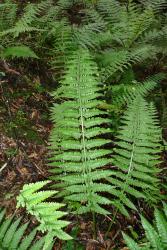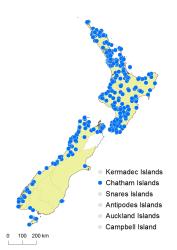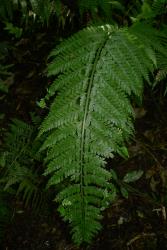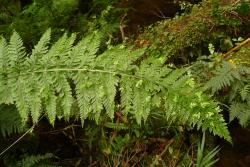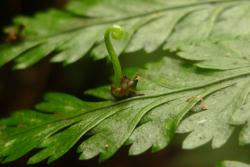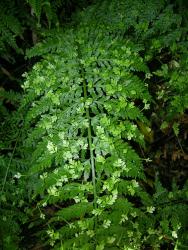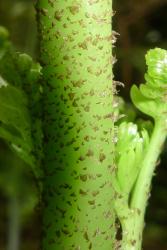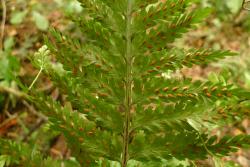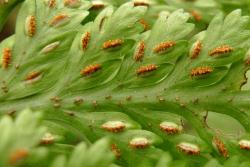- ≡ Caenopteris bulbifera (G.Forst.) Desv., Mém. Soc. Linn. Paris 6: 268 (1827)
- ≡ Asplenium marinum var. bulbiferum (G.Forst.) F.Muell., Veg. Chatham Isl. 66 (1864) – as bulbifera
Terrestrial or rupestral ferns. Rhizomes short, stout, erect or occasionally short-creeping, bearing scales. Rhizome scales ovate, 8–16 mm long, 4–8 mm wide, dark brown, clathrate. Fronds 290–1600 mm long. Stipes 100–430 mm or rarely up to 510 mm long, brown abaxially, green adaxially, bearing ovate scales with short apical projections. Rachises green, winged in at least the distal half, scaly. Laminae 2-pinnate to deeply 2-pinnate-pinnnatifid, ovate or elliptic, tapering gradually to the apex, 190–1200 mm long, 70–520 mm wide, light to mid-green on both surfaces, herbaceous, bearing scattered scales, lacking hairs, usually bearing bulbils on adaxial surface. Primary pinnae in 20–40 pairs below pinnatifid apex, usually overlapping or rarely not overlapping; proximal pinnae ovate or narrowly ovate, those at mid-lamina narrowly ovate; the longest at or below the middle, 40–290 mm long, 15–100 mm wide, very rarely up to 130 mm wide, apices acute to acuminate, bases stalked; costae of primary pinnae winged except at very base. Acroscopic secondary pinnae gradually decreasing in length along each primary pinna to the distal end, the basal acroscopic secondary pinna the largest; the longest proximal secondary pinnae narrowly elliptic or elliptic or narrowly ovate or ovate, 10–65 mm long, 4–20 mm wide, apices acute or obtuse, partly or deeply divided into tertiary segments, bases stalked or sessile; the distal secondary pinnae narrowly oblong, apices acute or obtuse, bases adnate. Tertiary segments oblong or narrowly oblong, 5–13 mm long, 2–4 mm wide, margins entire or divided. Sori away from margins; indusia 2–4 mm long, straight; free margins of indusia entire. Mean spore size 34–37 μm long, 23–26 μm wide; perispores irregularly ridged.
Asplenium bulbiferum is usually readily recognised by the presence of bulbils on the upper surface of the lamina. However, similar bulbils also occur in A. gracillimum, albeit less frequently. Characters for distinguishing the two species are discussed in detail under A. gracillimum.
Bulbils sometimes also occur in hybrids that involve A. bulbiferum as one parent, but such plants can always be recognised by their aborted spores.
North Island: Northland, Auckland, Volcanic Plateau, Gisborne, Taranaki, Southern North Island.
South Island: Western Nelson, Sounds-Nelson, Westland, Canterbury, Otago, Southland, Fiordland.
Chatham Islands, Stewart Island.
Altitudinal range: 0–1100 m.
Asplenium bulbiferum occurs throughout the North Island from Te Paki southwards in coastal and lowland to montane areas. It ranges from near sea level up to 1100 m on Mt Honokawa and Mt Taranaki, but is more common below c. 300 m. In the South Island it is largely confined to the Marlborough Sounds, north-west Nelson, and the west coast south to Fiordland, with outlying populations around the Southland coast to Dunedin and Banks Peninsula (although plants have not been collected from the latter two localities for over 100 years). It ranges from near sea level up to 660 m on Tākaka Hill. It also extends to Stewart Island and the Chatham Islands, but records of the species from the Auckland Islands (Allan 1961; Brownsey & Smith-Dodsworth 2000) are referable to A. gracillimum.
A terrestrial fern that occurs under kauri, podocarp, broadleaved and beech forest, and under tall mānuka and kānuka forest. It grows in wetter and more shaded habitats on the forest floor, in gullies, amongst rocks or tree roots, on banks, streamsides, river terraces, lake margins and shaded road cuttings on both acidic and base rich soils. It is capable of spreading vegetatively by means of its bulbils.
There is evidence that A. bulbiferum hybridises with A. flaccidum subsp. flaccidum, A. hookerianum, A. lamprophyllum, A. oblongifolium, A. obtusatum (Brownsey 1977a), A. cimmeriorum (Brownsey & de Lange 1997), A. appendiculatum subsp. appendiculatum and A. gracillimum (newly recorded here).
n = 72 (Brownlie 1954; Brownsey 1977b).
Analysis of low-copy nuclear DNA sequences strongly suggests that A. bulbiferum is one tetraploid parent of two allopolyploid species, A. cimmeriorum and A. gracillimum (Shepherd et al. 2008; Perrie et al. 2010).



